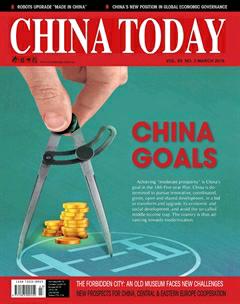BOOK REPORT
BOOK REPORT
THE Guardian so recommends this book: “This is no definitive account of modern China. It won’t tell you much about policy decisions, power struggles, or almost anything Li didn’t himself witness. If it did, its scope would be mind-boggling. Instead, its tight focus gives you a wonderfully immediate sense of how one man was shaped by modern China, and the struggles that took place around him. This ambitious graphic novel pulls you to the chest of the world’s latest superpower, shows you something of what it has gained and lost, and lets you feel as though you know China’s great, tangled present a little bit better.”

Chinese Civilian Epic– From Little Boy to Old Man
A Chinese Life (Volume 1-3) Author: Li Kunwu, Philippe Ôtié Price: US $27.50 Paperback, 704 pages Published by Harry N. Abrams
Cao Jingxing, well-known news commentator with Phoenix TV, said of the account, “The book combs through every detail of Chinese people’s daily life in Yunnan Province, sharing their happiness and sorrow against the background of major events such as the “cultural revolution,” reform and opening-up, and the return of Hong Kong to China. It not only records a typical Chinese family and an individual’s destiny, but also chronicles the huge changes in China’s society from the 1950s up until now, and is therefore hailed as a ‘Chinese Civilian Epic’.”
The “sequential art” memoir was co-written by Li Kunwu and French writer Philippe Ôtié, and illustrated by Li Kunwu. Edward Gauvin translated the book into English. In 2009, when the book was initiatively published by Dargaud in France, its Chinese-style humor, and reflection of a 60-year Chinese history through a dramatic narration medium instantly won international acclaim.
In 2010, this collaborative work won the “Most Popular with Readers” award at the French Saint-Malo Book Fair. Li Kunwu thus became the first Asian illustrator to receive this honor.
Later, the book was a finalist in the Angoulême International Comics Festival. It now has been published in a dozen languages, including French, German, Spanish, Finnish, Danish, English, and Korean. The English version was published in 2012, and the Chinese version in 2014 by SDX Joint Publishing Company.
Based on the personal story of Li Kunwu, the book narrates the 60-year history since the founding of the People’s Republic of China. The three volumes of this trilogy are entitled “Calamity,”“Transition,” and “Prosperity,”and give a panoramic view of the development of Chinese society.
The first volume starts in the 1950s, and recounts the period when Li’s family suffered during the Great Leap Forward and the“cultural revolution.” The second volume recalls the smashing of the “Gang of Four” and the celebration of Li’s family reunion. It narrates the process of tempering Li underwent while in the army. China’s great changes created a longing for a brighter future. The third volume depicts the times following inception of the policy of reform and opening-up. Under the ensuing rapidly developing economy, some savants found their first buckets of gold in the market. Others lost their “iron rice bowls” in state-owned enterprises, leaving them demoralized and befuddled. The dramatic changes forced Li and his peers to make new choices.
The book includes 3,000 or more comic book drawings, spanning landscape views of Chinese-style factories and rural areas to army life. It also features a line-up of 100-plus vivid characters, from Li’s family members, classmates, and friends, to ordinary people lounging on Kunming’s city streets, or living among Yunnan Province’s isolated mountains. The story of a masseuse, a former villager who returns to her hometown to attend her father’s funeral, is elaborated in detail. Through the woman’s eyes, Li draws a sharp contrast between urban and rural life. Migrant workers hold a strong feeling of nostalgia for their rural home, while their relatives cherish high expectations of them. Another story is about a small but ambitious businessman whose mineral water production start-up develops into a large company. The description of common Chinese in the book is multifarious, sometimes full of humor, sometimes oppressive. However, the genuine and vivid narration has the power to transcend national boundaries and bridge the hearts of different people.
Li says that he used autobiographical cartoons to record his life and the shifting times his parents experienced. He never expected the book would be a best seller. Only during his writing creation did Li discover that his 55-year life experience had somehow witnessed the whole gamut of China’s development and opening up to the outside world. Every common Chinese born in the middle of the last century will be familiar with Li’s stories.
The co-writer Philippe Ôtié anticipated that comics, aka children’s storybooks in China, would be popular in France as both kids and adults like cartoon books. He thus foresaw a huge market in France through which to present China’s changes through cartoon drawings.
The five-year creation was indeed full of contrasting opinions and required frequent discussion.“Self-Assessment by Chinese” can radically differ from “Chinese in the Eyes of Foreigners.” The two writers, considering their different backgrounds, had their own understandings of various historical events, but sought to strike a balance between them. Ultimately, the book is neither a critical work nor a propaganda pamphlet. Li writes of his life in an authentic way, and thus leaves space for readers’ thinking and criticism.
The authors did their utmost to present the best story framework and plot arrangement, with a drawing style characterized by graphic images. This was far from easy. The drawing style was the biggest challenge. Li, a typically reserved Chinese, prefers to draw images in a smooth, flowing and light way. But such a light-handed approach does not reveal characters’ inner hearts. At Philippe Ôtié’s suggestion, Li set the heart of the protagonist as focus, and combined the vivid expression of cartoons and filming techniques to embroil readers deep in the stories and plots. The final rendition captivates readers with its monochrome prints of Chinese-style propaganda posters.C

